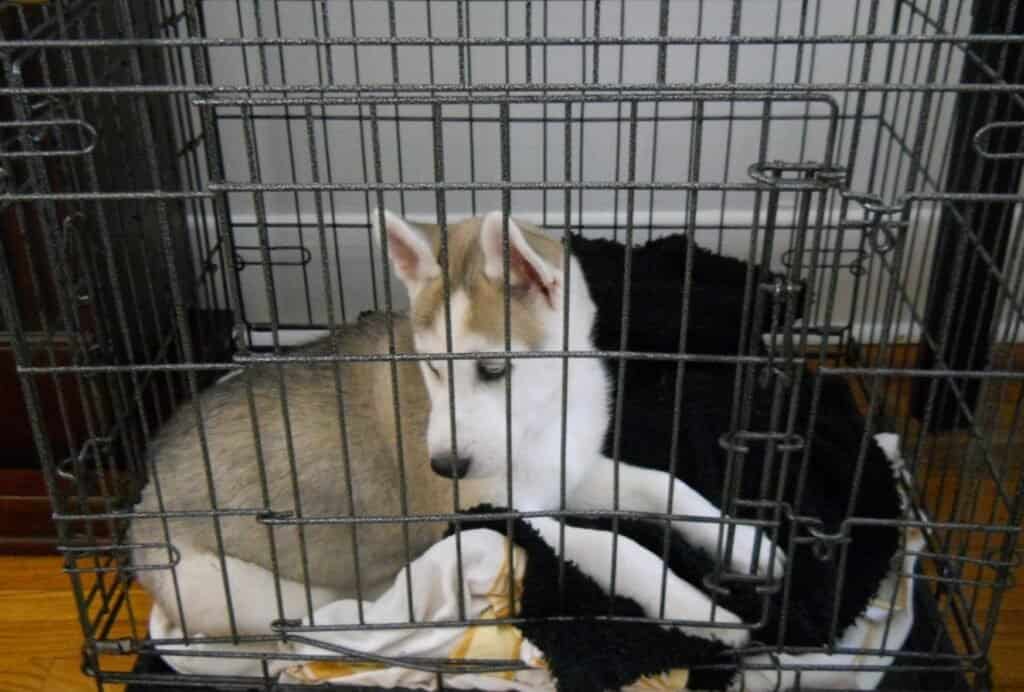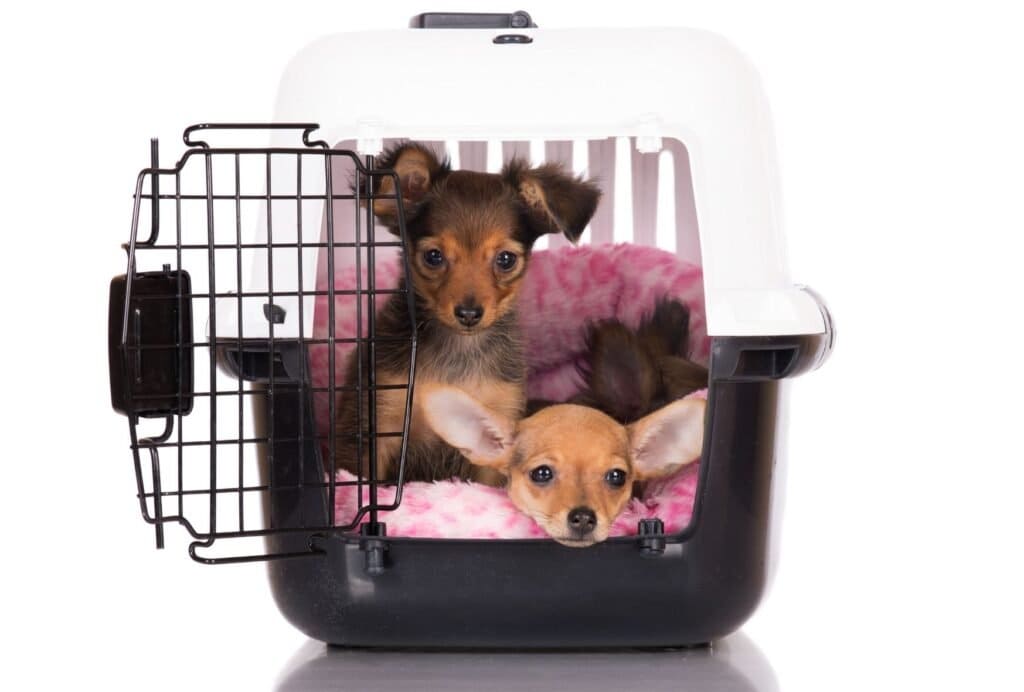
So, you’ve had your puppy for a few months and you’ve been very consistent with crate training.
Now, your puppy seems to be doing very well and you’d like to reward him with a little more freedom.
But then you’re not sure if it’s too early or if it’s even good for him, right?
Well, if these thoughts are currently crossing your mind, you’re in the right place. In this article we’ll discuss when to stop crate training your puppy.
My Mini Poodle Baloo suffered from quite severe separation anxiety in the beginning. Not only that, he also used to be super hyper! In fact, the only place he could calm down and sleep during the first few months was his crate.
So, I’ve asked myself a couple of times when it’s actually the right time to stop crate training a dog.
Here’s the short answer: You can stop crate training your puppy once the issue you’ve been crate training him for is solved. So, if you’ve used a crate to housebreak your dog, you can stop crate training once he doesn’t have any accidents inside anymore. The same is true if you’ve used a crate because of separation anxiety, destructive behavior or hyperactivity.
Table of Contents
Benefits of Crate Training a Puppy
Crate training your dog has so many benefits. Not only is it a great place for him to settle down and feel calm, but it’ll give you peace of mind too!
Let’s take a look at some of the fantastic reasons you should crate train your dog or puppy.
Housebreaking
If you’re in the process of housebreaking your puppy, a crate is a great tool to help you.
Dogs naturally don’t want to soil the place where they sleep. Putting your puppy in a crate at night will help your dog learn to hold his bladder since he won’t want to make a mess of his “den.”
When it comes to puppies, though, you’ll still have to make sure that you take them out for frequent potty breaks during the night. The general rule of thumb is that a puppy can hold their bladder for one hour for every month of age. For example, if your puppy is 3 months old, they can hold their bladder for 3 hours.
Some will be able to hold it for much longer, as you’ll learn in my article about the question “can a 10-week old puppy sleep through the night?“.
So, this will require some trial and error.
Helps Your Puppy Calm Down
This is part and parcel of making sure that your dog only has positive associations with his crate!
You want to make sure that the crate is something your dog loves, not a place that’s used as punishment. As your dog builds positive associations with his crate, he’ll see it as a safe place where he can go to calm down.
When dogs are worried or stressed, they will instinctively look for small, den-like spaces where they can hide. A crate is a great place for your dog to settle down and feel safe.
Unfortunately, many puppies can’t calm themselves down, though. Once they’re in a state of over-arousal, overstimulation or over-tiredness, all they’ll do is have the zoomies on end…
For those cases you can make use of the crate too by putting your puppy inside so that he can calm down and take the much needed nap.
In case you’ve got a hyper dog or puppy, also make sure to get my free guide for a calm dog. In this guide you’ll learn the easy 3-step process that helped me change my hyperactive Mini Poodle Baloo into a calm and charming pup!
Training Tool for Destructive Behavior
If your dog has a lot of destructive behavior that you’re trying to curb, crate training him will be a really useful tool.
For example, if your dog struggles with separation anxiety, he might have destructive behaviors like chewing up furniture. Not only can this be an expensive problem for you to fix, but your dog might also ingest something toxic that can really make him sick.
Crate training your dog can help you work on this behavior. You can put your dog in a crate, and walk away from it for a short period of time before coming back.
With patience and consistency, the crate will help your dog get used to your absence, which in turn will stop the destructive behavior.
When to Stop Crate Training a Puppy
Now that we know how useful crate training is, the next question is “when is it time to stop?” There are a few factors that will tell you when you can stop crate training your puppy or dog.
No Accidents for a Few Months
If you’re crate training your puppy to help housebreak him, then you’ll know it’s time to stop when he stops having accidents.
While potty training your puppy, it’s normal and expected for him to have a few accidents in the house, and sometimes even in his crate. If this happens, don’t punish him. It just means you might need to take him outside more often.
If your puppy seems to be having accidents in his crate, the crate itself might be too big. It should be just big enough for him to stand up and turn around in. If the crate is too big, he might feel comfortable using one side as a bathroom. If this is the case, it’s time to downsize.
Once your puppy stops having accidents, wait a few months to make sure the training has set in for him. Once you’re confident your dog understands that his bathroom is outside and not inside, you can stop crate training him.

No Destructive Behavior When He Isn’t in the Crate
If you had to start crate training your puppy because of destructive behaviors, you’ll know it’s okay to stop once he no longer exhibits these destructive behaviors outside of the crate.
For this one, you’ll want to start small. Only leave your puppy outside of the crate by himself for a few minutes at first. As he adjusts, and as long as he isn’t being destructive, you can start extending that period of time. If your dog stops being destructive when he’s outside of his crate for long periods of time, then you’ll know you can stop crate training.
As a side note, some dogs with severe behavioral problems might never be able to fully adjust to being outside of the crate. And that’s okay! As long as both you and your dog are safe and happy, there’s no shame in continuing to use a crate.
In case your pup is displaying a number of behavioral issues, I highly recommend getting Braintraining4dogs.
Training a dog is the easiest while he’s still a puppy. There are several ways to do that. But the most cost-effective is definitely to get an online course.
I’ve spent hundreds – if not thousands – of dollars on dog training classes and private dog trainers. In most cases, that’s not necessary at all, though. You can get the exact same information in an online course.
My all time favorite course is Braintraining4dogs. It’s based on positive reinforcement and focuses on improving your dog’s intelligence so that he can basically solve his own problems.
Check it out now to profit from a risk-free 60-day money back guarantee!

No Signs of Separation Anxiety
Since crate training is such a great tool to help with separation anxiety, you’ll know your dog has graduated to free roaming your home when he no longer shows any signs.
Take a look at this list of symptoms of separation anxiety in dogs. If your dog is no longer showing any signs of separation anxiety, then it’s fine to stop crate training.
As with the last tip, some dogs who have very bad separation anxiety might need the crate their whole lives. Remember that every dog is an individual—and so are you! If you need to keep using the crate to help your dog, and yourself, there’s absolutely nothing wrong with that.
With lots of patience and love, you’ll be able to go a long way with your pup, though. Baloo suffered from very severe separation anxiety as a puppy. I literally had to build it up by seconds at a time. After almost a year of training, he finally managed to be calm and relaxed even when I’m leaving the house!
A big part of that achievement is due to my 3-step process for a calm dog. In case you don’t have it yet, get your free copy now!
How to Transition from Crate to Dog Bed
Many people use crates as the first stepping stone to getting their dogs to sleep in a dog bed.
So, once your dog is properly crate trained, how do you start the transition over to the dog bed?
Start with Short Intervals
When it comes to the transition from crate to dog bed, always begin with short intervals. Let your dog sleep on his new dog bed for a few minutes, and then move him back into his crate.
Or leave the house for a few minutes while he’s not in his crate and see how it goes.
Over time, your dog will start understanding that the rules of his crate apply to the rules of his bed.
Then, you can start slowly expanding the amount of time he’s outside of his crate and on his bed.
Provide Chewing Toys or a Filled Kong Toy
Giving your dog something to chew on while he’s on his dog bed will help him stay there instead of roaming around. Plus, since he’s getting treats, he’ll be forming positive associations with his dog bed.
No only that, licking and chewing are both entertaining and relaxing. This means your dog will find it easier to fall asleep. And instead of chewing on your furniture, he’s got something he’s allowed to gnaw at!
These positive associations, plus the fact that he’ll be busy chewing whatever you’ve given him, will encourage him to stay put on his bed.
Only Extend the Period If All Went Well
You should only leave your dog outside of the crate and on his bed if everything is going well. If your dog is still getting himself into trouble, extending the amount of time only gives him more opportunity to not follow your rules.
If the amount of time you’re currently allowing your dog on his bed doesn’t seem to be working, then it’s time to cut back. Reduce the amount of time, and work your way back up.
Leave Him in a Small, Confined Space Instead
If your dog is finding it hard to adjust to the dog bed in your bedroom at night, it could be the space is too big for him. There’s just too much that he wants to sniff and explore in there!
The same is true if your pup is still struggling a little with separation anxiety.
If that’s the case, it might help to leave your puppy in a small, confined room in your house.
Your dog will get the same feeling of comfort and safety as he would in a crate in this small space. Plus, with his dog bed in there with him, he’ll be able to start getting used to sleeping on it.
Try Leaving the Crate Door Open at Night
If everything seems to be going well, and your dog can spend longer and longer periods outside of his crate, try leaving the crate door open next time you to go sleep.
At this stage, your dog should recognize that, even though he has more freedom, he still needs to be polite while he’s outside of his crate.
If your dog can sleep peacefully with the door of his crate open, then you can pride yourself and your pup for all the hard work you’ve done!

Conclusion
Crates are such amazing tools when it comes to dogs. They can help with housebreaking, curbing destructive behavior, and they provide a safe place where your dog can go to calm down.
But when it comes to figuring out when to stop crate training, the answer can be tricky. The real deciding factor on whether or not you can stop crate training comes down to whether it’s accomplished what you wanted it to!
If you needed to crate train your dog to housebreak him and that’s all, once he’s housebroken it’s fine to stop. If you needed to do it to stop destructive behavior, and he’s no longer showing any signs of that, then you can move on from crate training.
Just remember that all dogs go at their own pace. And some with more severe problems might always need to use a crate. That’s never an issue! What matters is that you and your dog are safe and happy—so as long as that’s the case, use a crate for however long you need it!
P.s.: Don’t forget to check out Braintraining4dogs if you want to take your dog training game to the next level. It offers a 60-day money back guarantee, so you have nothing to lose.

*Disclosure: This post may contain affiliate links, meaning, I get a commission if you decide to make a purchase through one of my links, at no cost to you.

